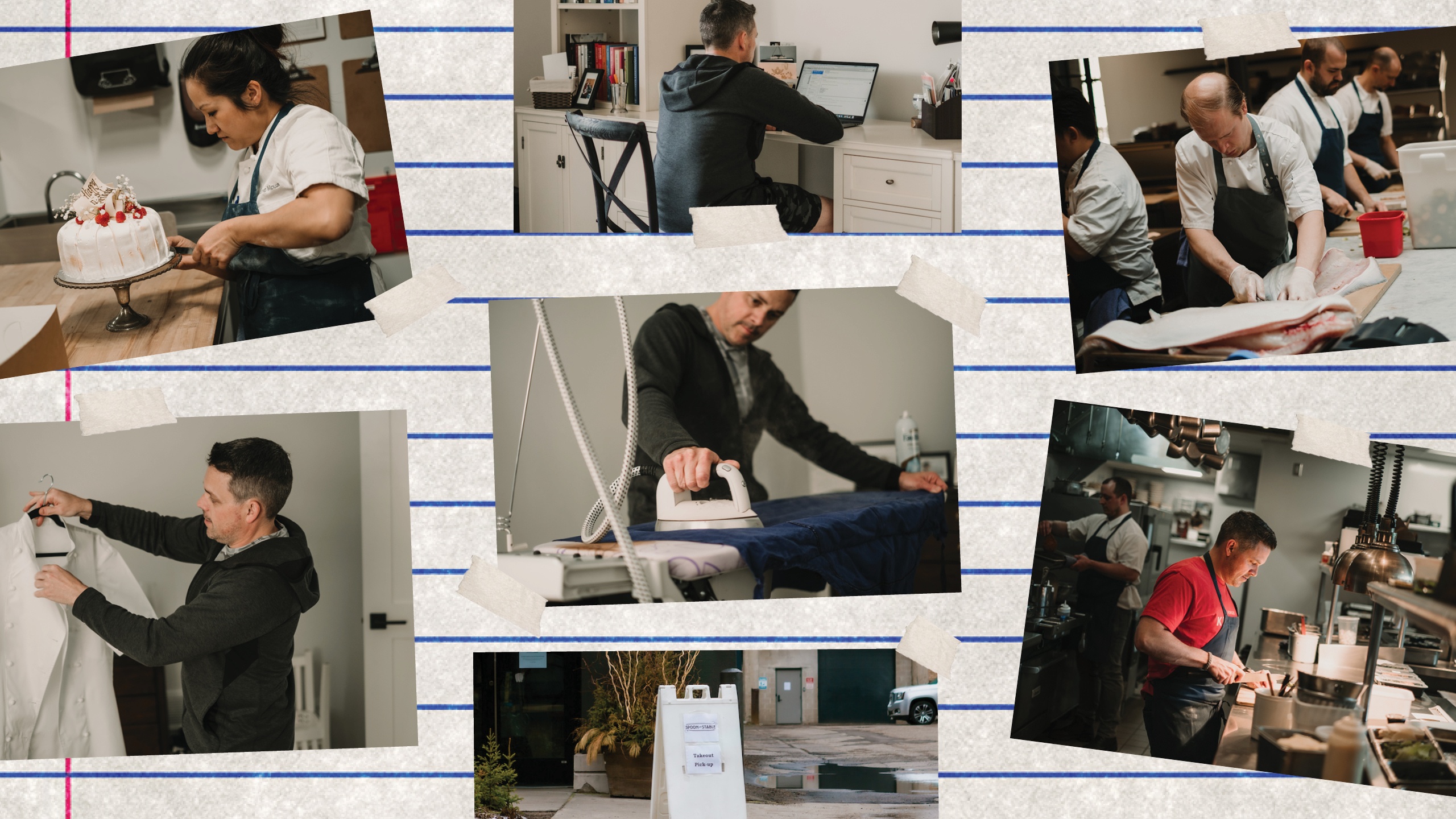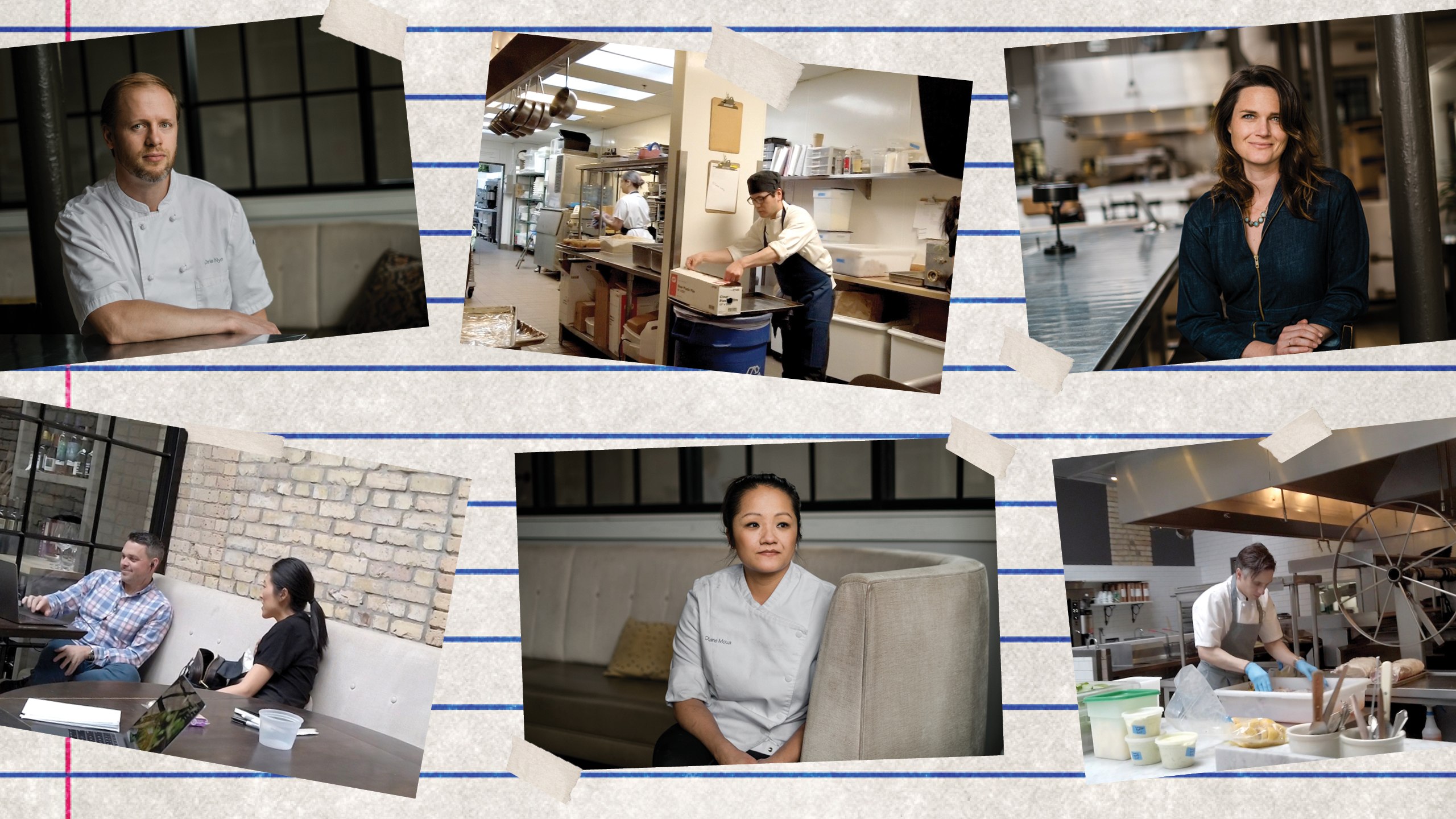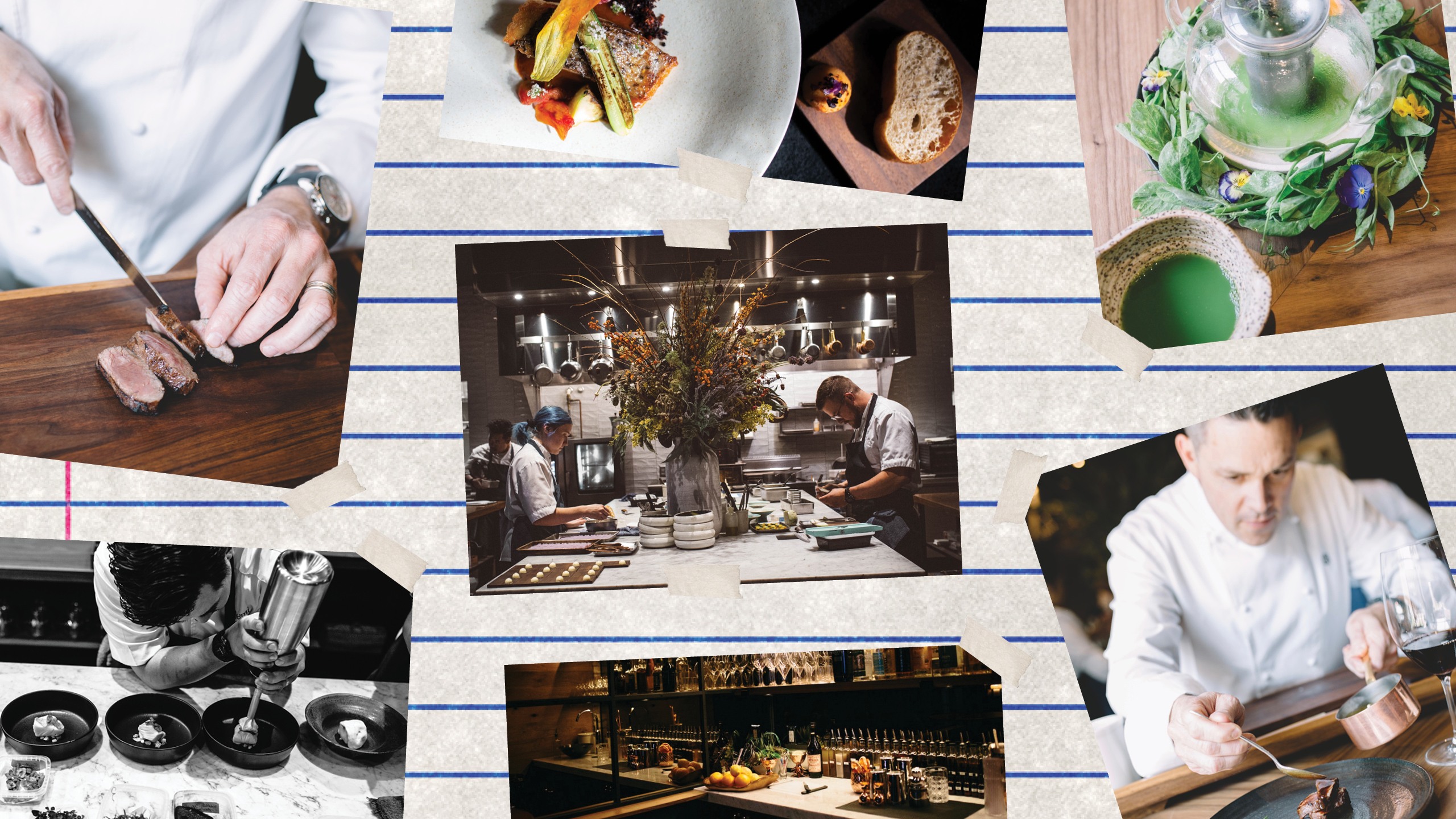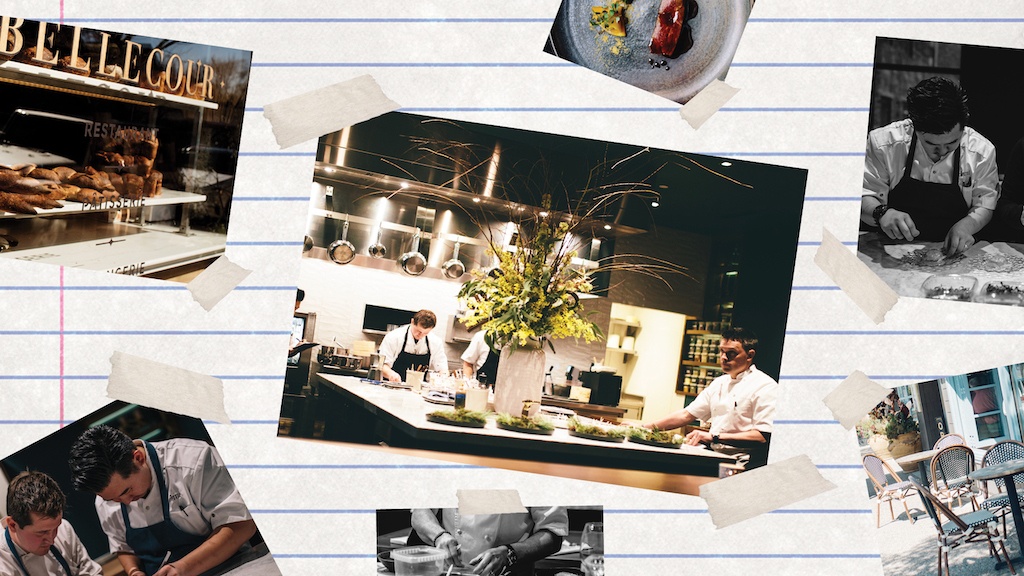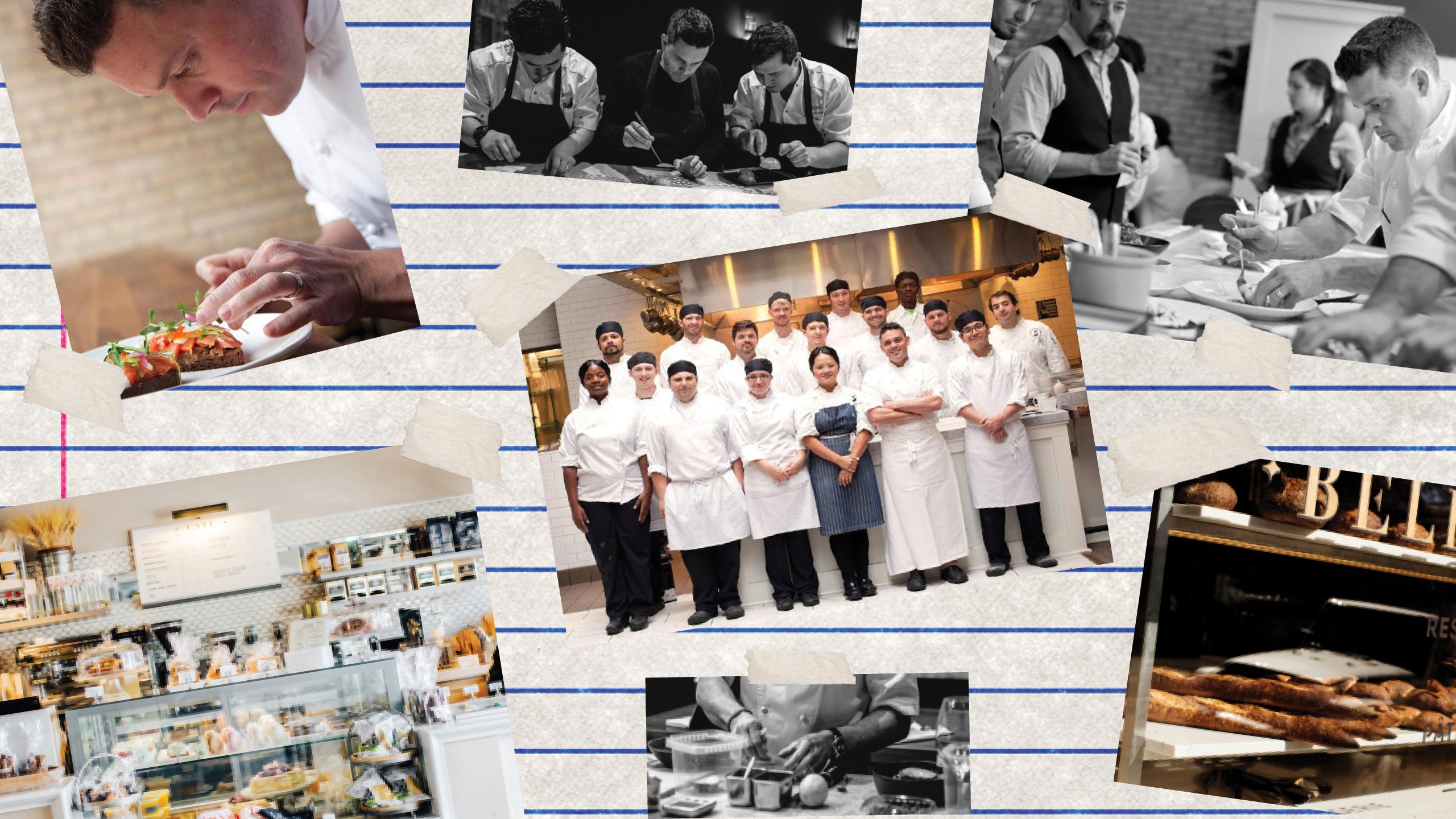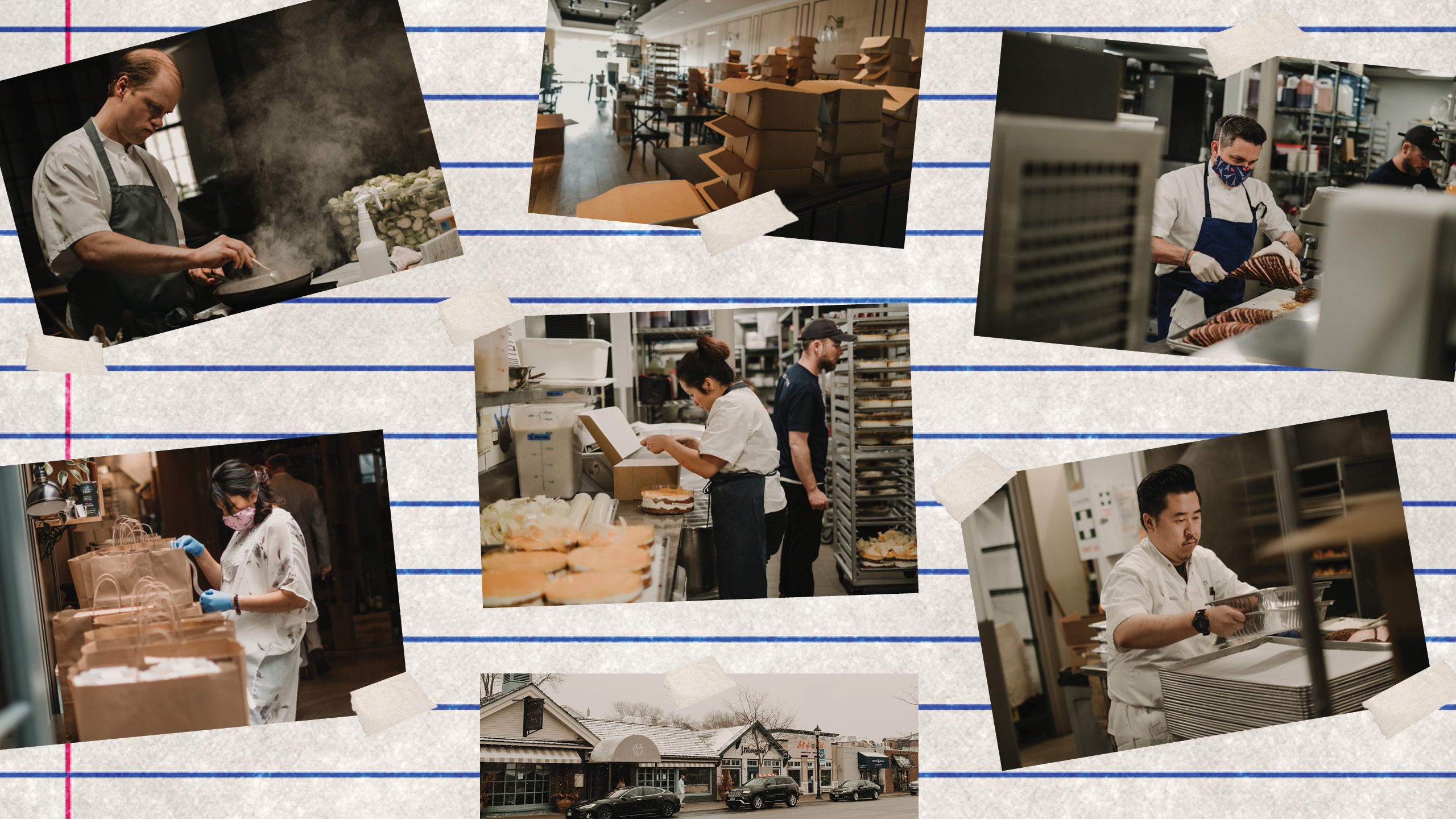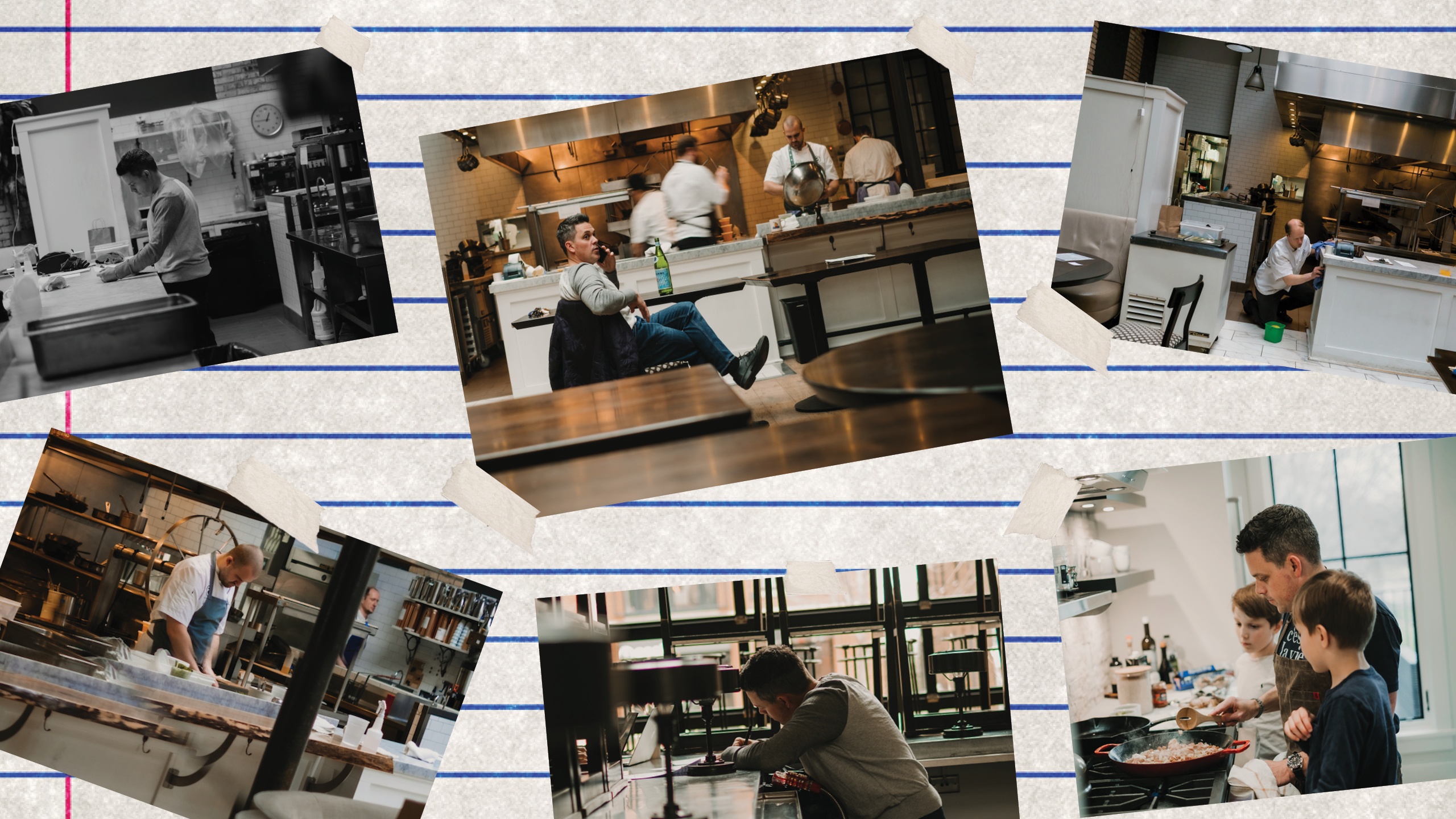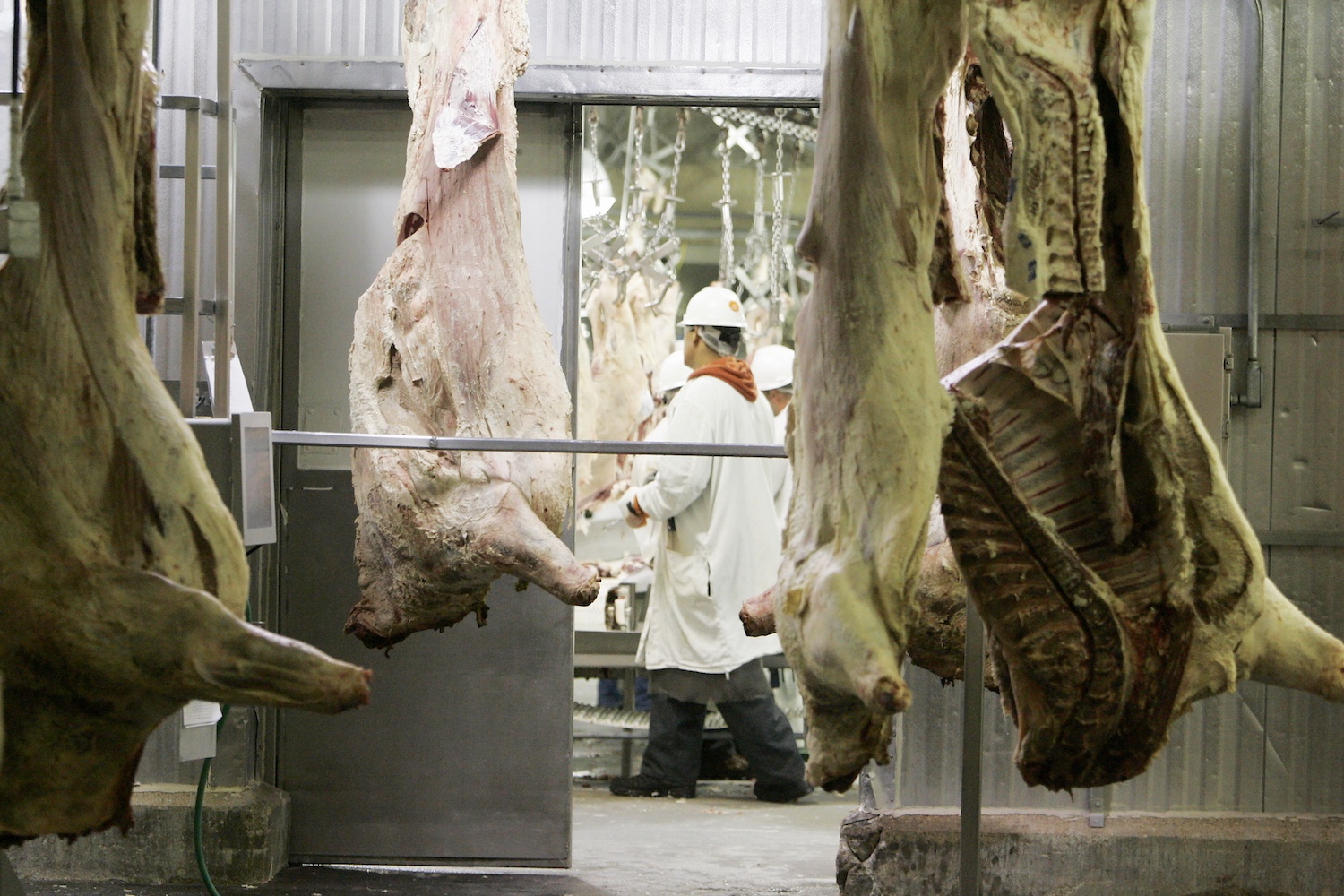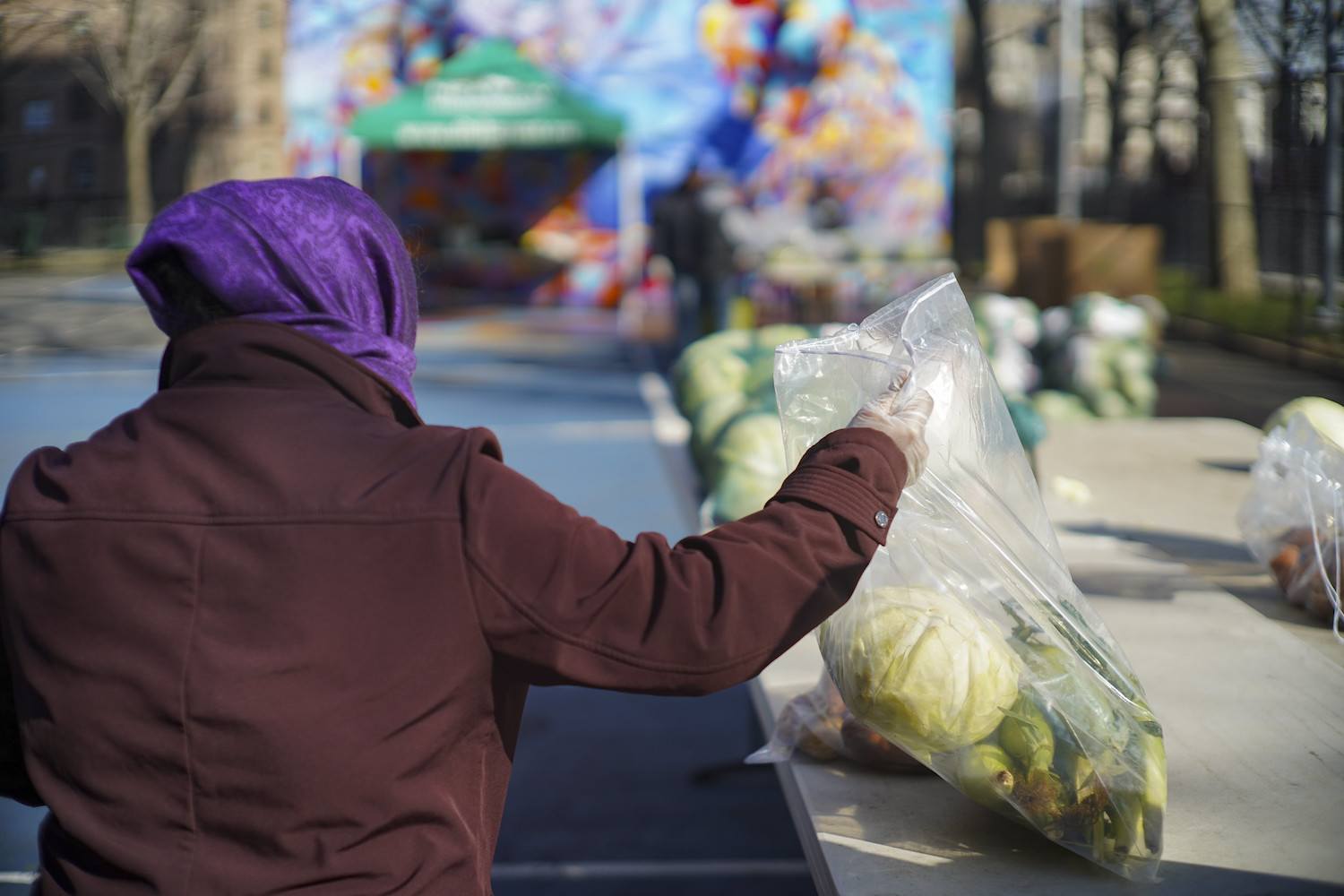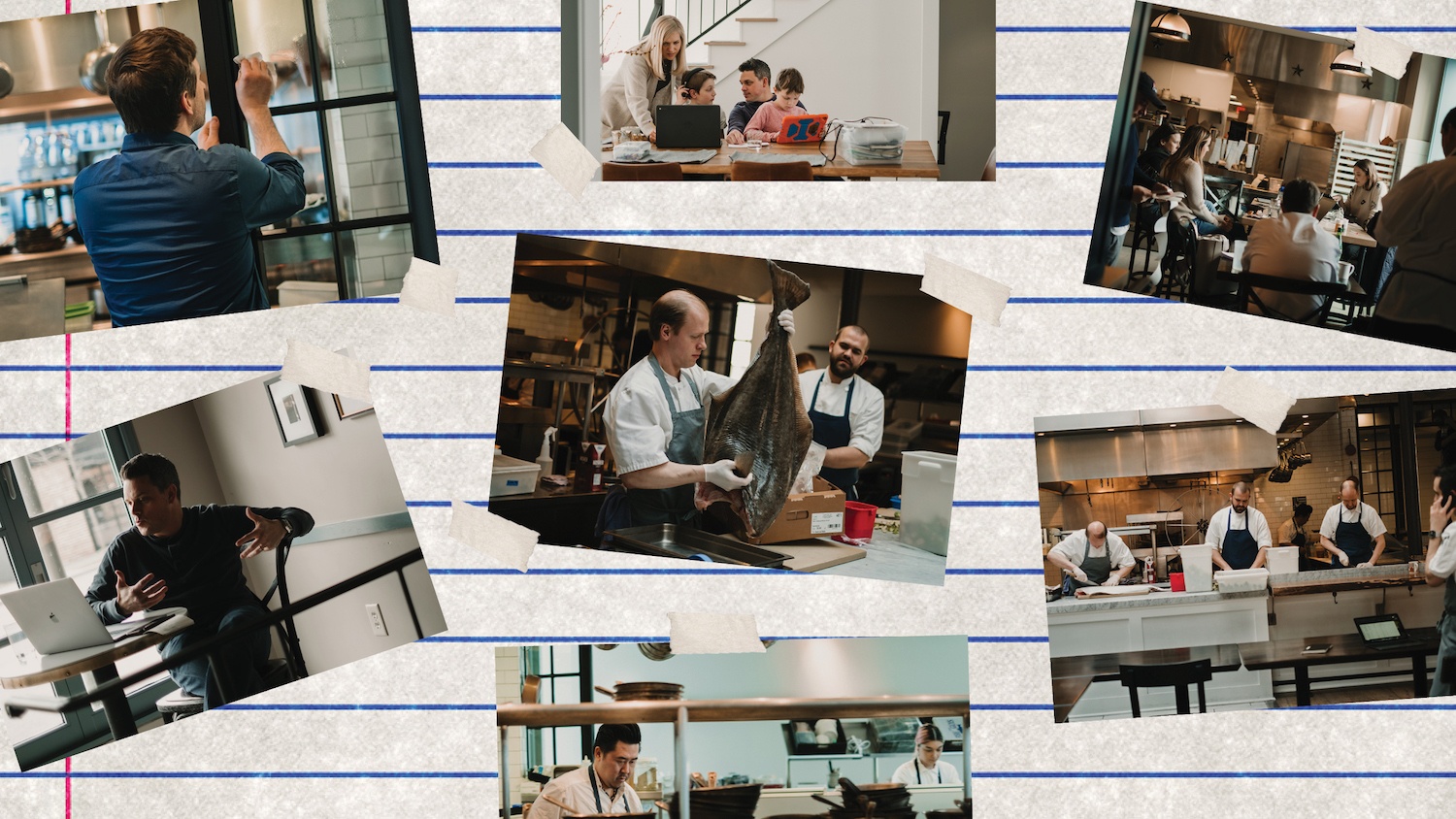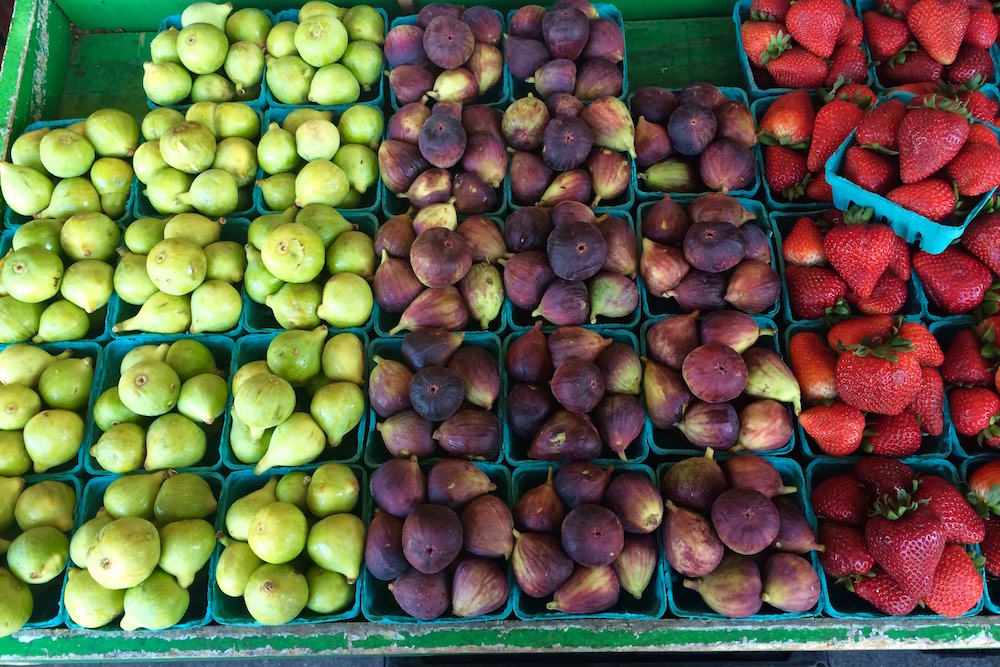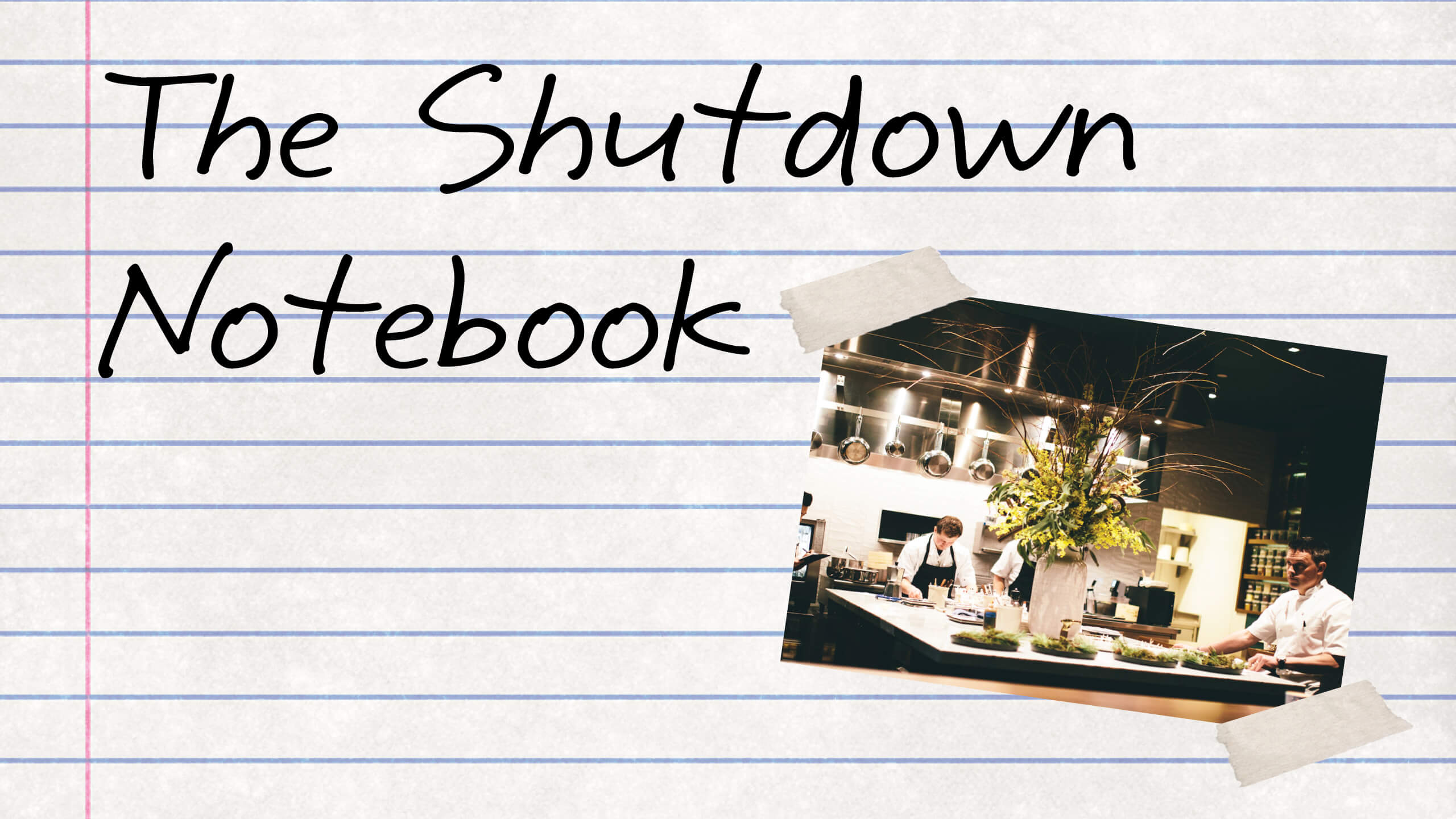
Photo by Libby Anderson/Flickr/Nicolas Raymond/Graphic by Talia Moore
A weekly series about one chef who closed three restaurants during the pandemic—and intends to get them back.
As restaurants get ready to re-open, in what we hope is the Covid-19 backwash, grab-and-go sounds more alluring than ever, a prescription for physical and mental health: a meal with next to no human contact. What used to be a default choice, for our eat-and-run lives, has become reality—take-out and delivery are the only way we can get a restaurant meal.
It’s where we feel safe, despite the first wave of states to announce that sit-down restaurants can open for business as long as they abide by certain guidelines. Restaurateurs in those states are not in that much of a rush, as it turns out: they debate whether they’ll become casualties of another virus spike, and wonder how they’ll make their numbers at half-occupancy, even if everyone stays well.
Full-service restaurants, like Chef Gavin Kaysen’s three Minneapolis restaurants, face a bigger challenge than casual places do, because human contact was part of what made them special in the first place. There’s more to dismantle and rebuild—and a nagging worry, at each practical crossroads, about how, and whether, full-service will survive.
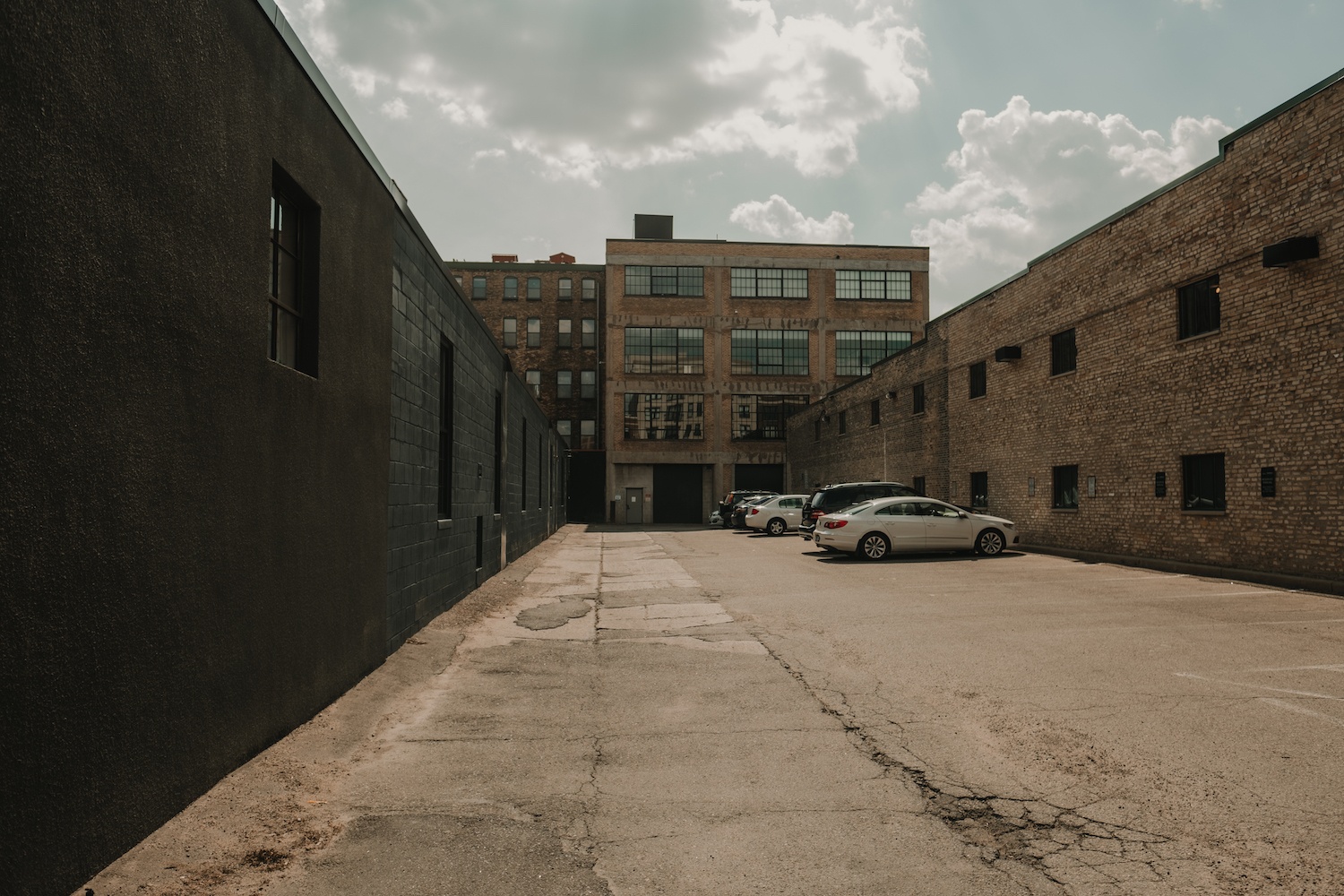
Kaysen considers erecting a changing tent for employees next to Spoon and Stable, so they can put on sanitized work clothes before they go inside.
Dave Puente
Before the virus, these restaurants valued what Kaysen calls “touch” as a barometer of hospitality. The quality of service rose in direct proportion to the number of times an employee touched a table—had an exchange with a guest—and the number of employees who did so. At Spoon and Stable, his first restaurant, it wasn’t unusual for a guest to interact with six or seven people during a meal.
But what was once of value now seems a palpable threat. Kaysen is reconsidering every element of his restaurants, to figure out what needs to be altered; he has a running list of touch-points that will not survive, though eliminating them goes against his every notion of what it means to serve a guest a meal.
“We built these restaurants for pleasure and happiness,” he said, but that is no longer enough. Before he can start taking reservations, he has to figure out how to make customers and employees feel safe, as well—without any definitive sense of how that will look, what it will cost, and whether it will be enough.
And the changes he makes are only half the equation, a source of profound frustration to a self-confessed control freak. A restaurant owner can define the physical space and his team’s behavior, up to a point. He can’t do anything about the customers who walk in the door; they are either a gift or a danger, and there’s no way to tell merely by looking.
So he confers with other chefs, with departments of health, with his team, and brainstorms with himself in a fairly nonstop dialogue. Minnesota’s governor, Tim Walz, can announce whatever opening day he wants: Kaysen won’t open until he feels he has enough answers.
His biggest fear is getting it wrong, missing one adjustment he should have made, and having a guest or employee get sick. One shutdown has been far more than enough. He would like to avoid having to do it again.
—
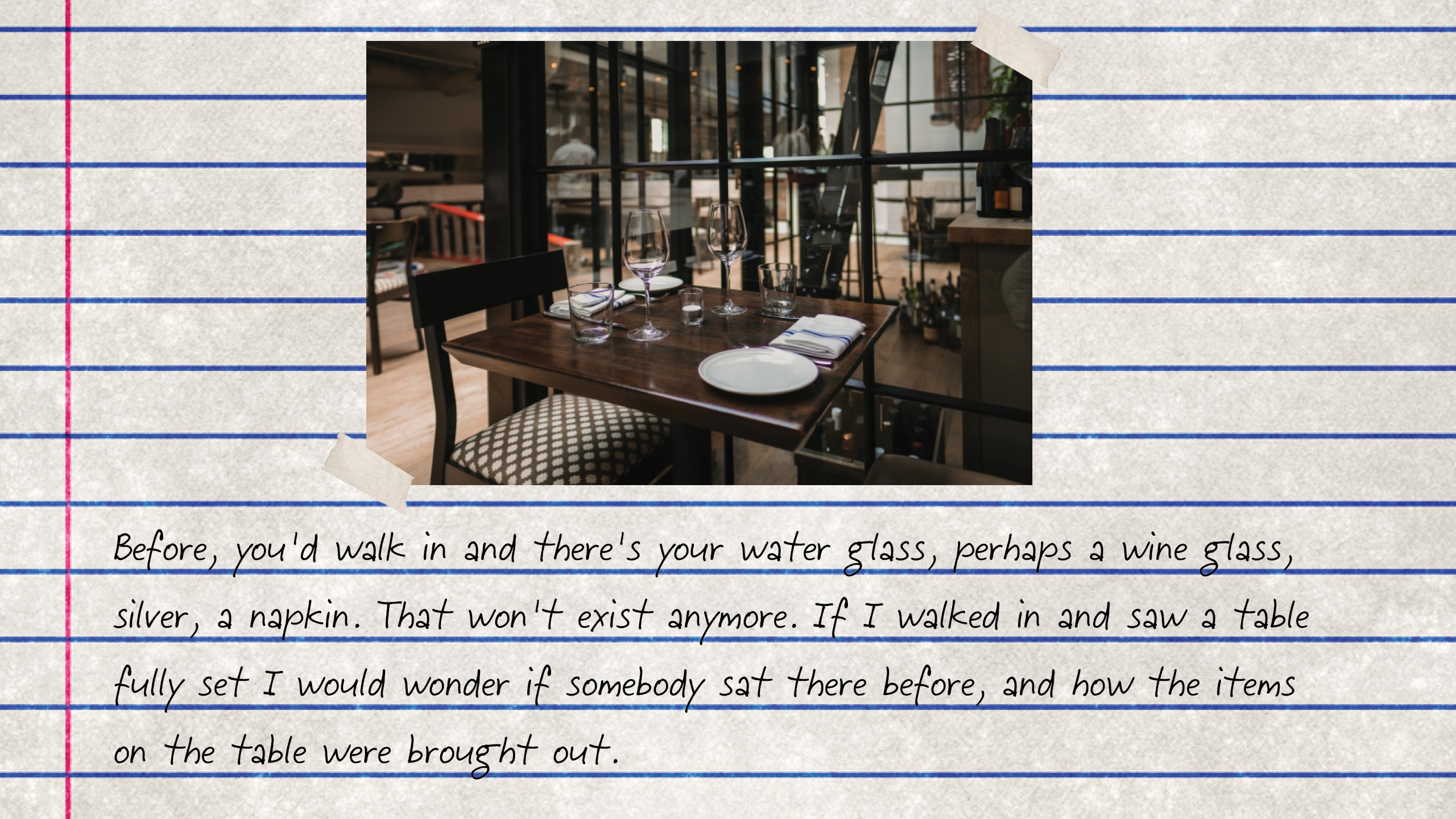
Dave Puente/Nicolas Raymond/Flickr/Graphic by Talia Moore
Your table is ready
Maybe it’s the neurotic side of me, but I’m looking at every single step of service in a granular way, and wondering about it. Take place settings. Before, you’d walk in and there’s your water glass, perhaps a wine glass, silver, a napkin. That won’t exist anymore; it can’t. If I walked in and saw a table fully set I would wonder if somebody sat there before, and how the items on the table were brought out.
I don’t think there’s necessarily fear about that for everyone, but some people will have that fear. So I try to think through the steps of service to ask myself: What can I change to eliminate some of the fear? We need to rebuild the trust of our guests, that we’re a safe place to eat.
Maybe we build a tray with a glass cloche over the tray, or whatever it is, and on that tray is a full place setting, napkin, silver, glassware. When the guest sits down the server lifts the cloche, but the guest takes the place setting and puts it in front of him, and we take the cloche and tray away. The server doesn’t touch anything the guest will use.
If you order the pork or the duck and you want to take it home, we can’t pack it up for you. So we bring you a take-out box to your table, but along the way we lose a lot of the sense of hospitality. How depressing, to have to do that.
It’s one less person in contact with that setting. I hate to use this analogy, but it’s like going to the dentist and seeing all of the sanitized tools. Same idea.
If you order the pork or the duck and you want to take it home, we can’t pack it up for you. So we bring you a take-out box to your table, but along the way we lose a lot of the sense of hospitality. How depressing, to have to do that.
And the menu, and the check? There’s a lot of physical exchange involved in paying a check; think about it. Can you eliminate 90 percent of that – and maybe in the dining room, but how do you do it at the bar?
How do you combine the effort to do this, and do it right, with service that’s quick and full of energy? Something’s bound to get missed. Maybe it’s slower.
Amanda Cohen said she read a survey that said people wouldn’t feel comfortable having more than one person touch their table. Everyone’s standard of service is different, but at Spoon and Stable maybe six or seven people come up to you to make sure you enjoy the experience – the host, servers, runners who bring and clear the food, maybe the manager stops by to say hello, I come out and talk to people. It’s a dynamic problem. Maybe the host seats you and then just one person comes to the table, which is so different from what we’re used to.
I’m trying to wait as long as I can to find a solution, looking for one that makes sense from both a safety and hospitality perspective. But we have to ask, How do we overdo it, what does that look and feel like—and then, when will it start to feel acceptable to modify things.
—
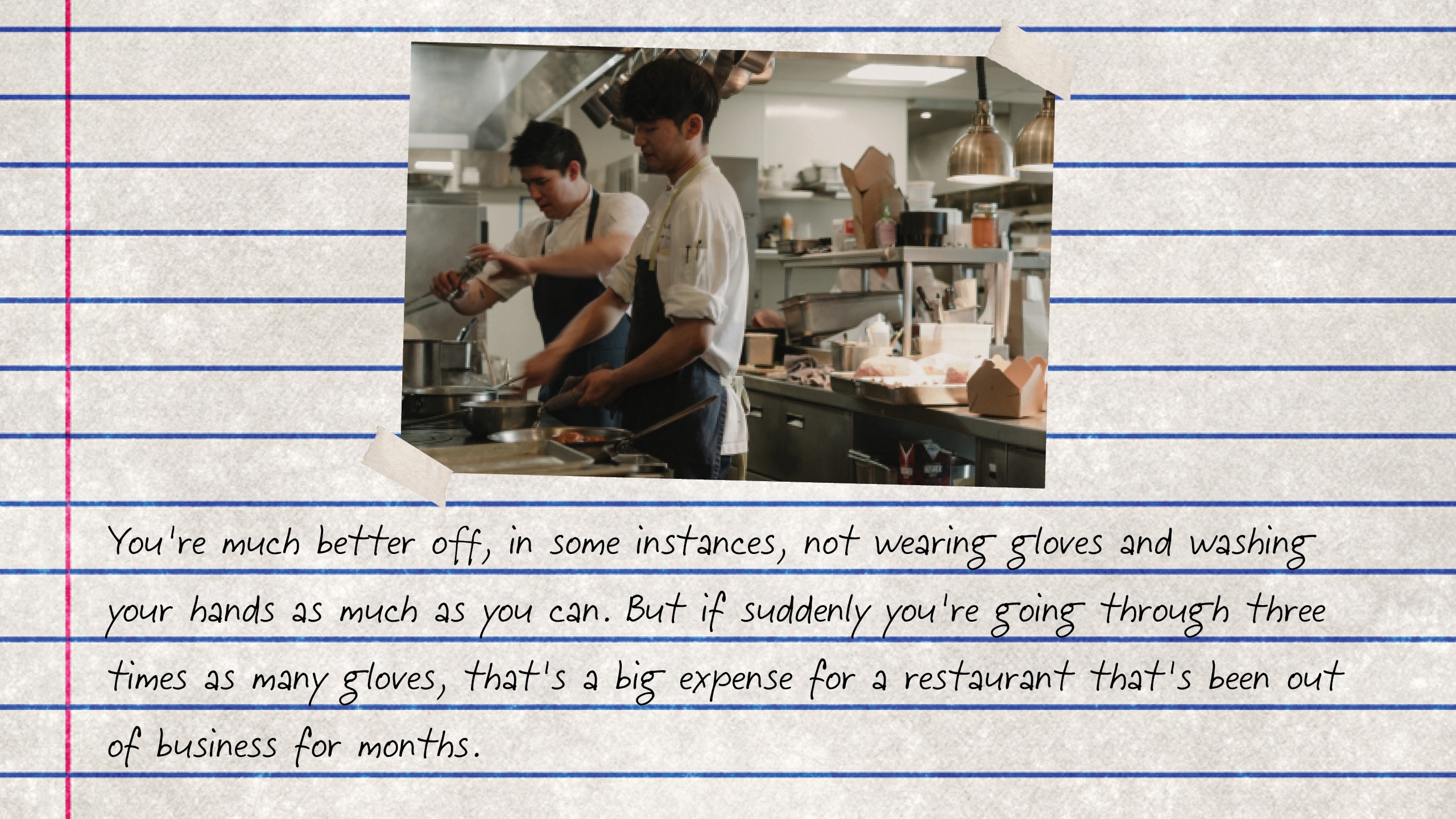
Dave Puente/Nicolas Raymond/Flickr/Graphic by Talia Moore
Starting out safe
The team is my responsibility, and it’s a different equation there: We can’t be responsible for every guest who walks in, but we should be responsible for our team.
And from a labor perspective, some of what’s being discussed is impossible if we’re going to have any chance of making a profit. Take family meal, the meal we serve to the staff before service every day. It used to be a buffet set up for the staff, but one suggestion is that we plate an individual meal for every single employee. A staff of 50 on a shift? How many people and hours will have to be added to the workday to do that? Most operators will simply stop offering family meal, but I won’t do that, so we have to figure it out.
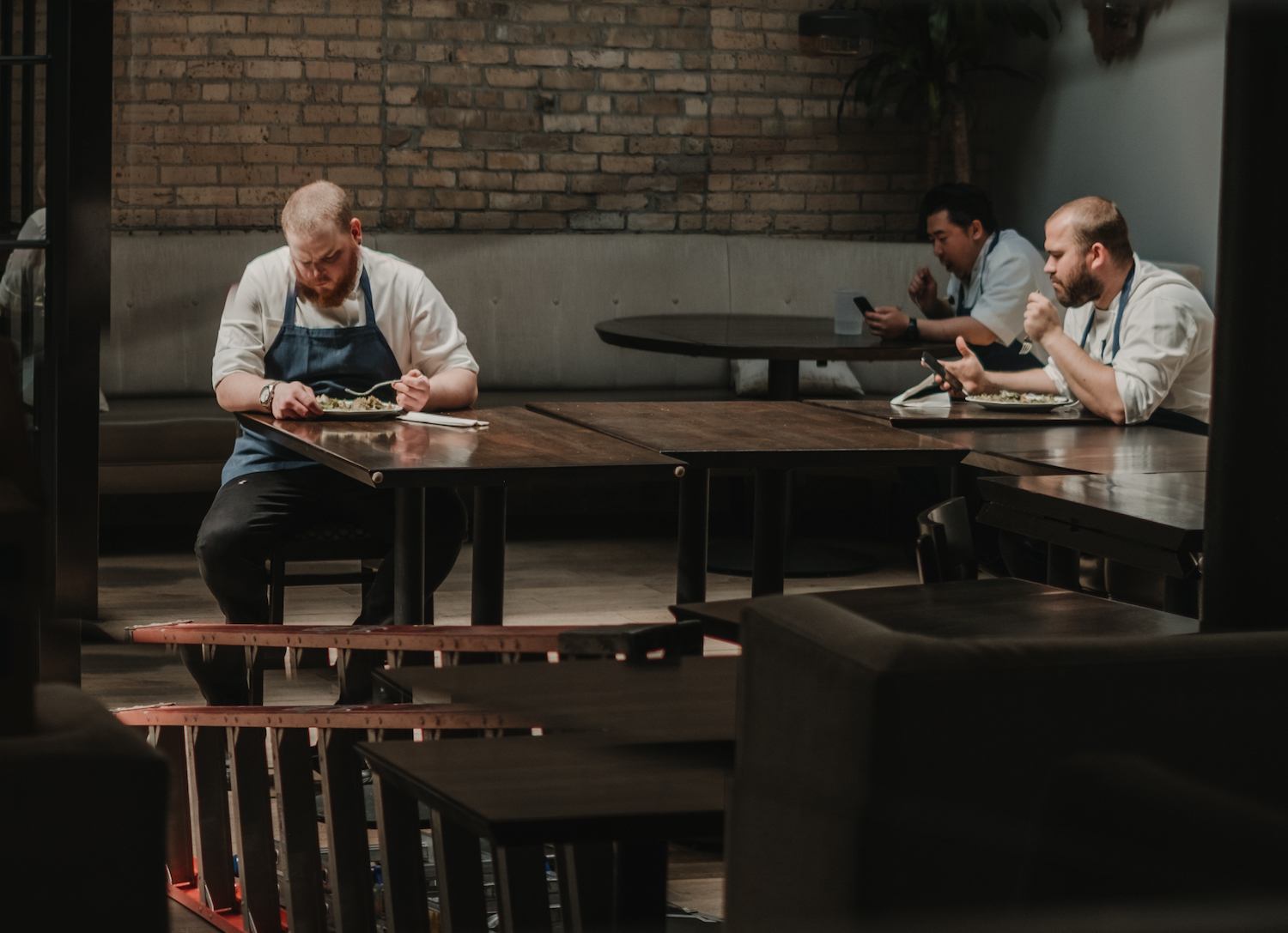
Staff at Spoon and Stable eat their family meal spread across the restaurant.
Dave Puente
Or the changing room where the team gets changed for work. Right now at Spoon it’s in a back room. But in an effort to make it truly sanitized, to make us all feel more comfortable, we might want to have a tent outside. You walk in one side, change in the tent, then walk into the restaurant—but the expense of that is tough.
Wearing gloves is another example. You’re much better off, in some instances, not wearing gloves and washing your hands as much as you can: people wear one pair of gloves too long, get shit inside the gloves, even wash them, which makes no sense. But if suddenly you’re going through three times as many gloves, that’s a big expense for a restaurant that’s been out of business for months.
—
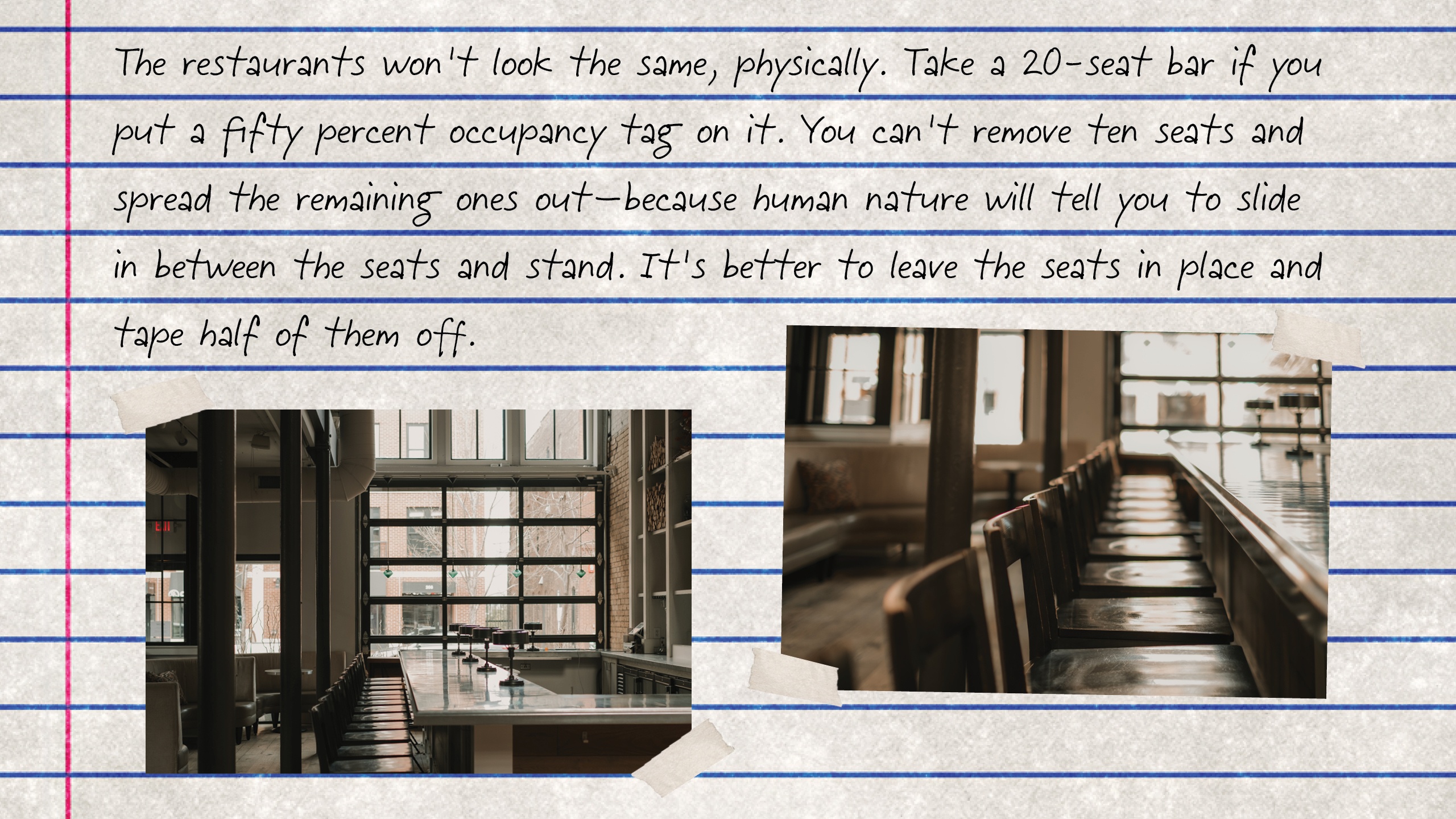
Dave Puente/Nicolas Raymond/Flickr/Graphic by Talia Moore
The virus floorplan
The restaurants won’t look the same, physically. To a degree they will, but take a 20-seat bar if you put a fifty percent occupancy tag on it. You can’t remove ten seats and spread the remaining ones out—because human nature will tell you to slide in between the seats and stand, which forces the restaurant to police that behavior. It’s better to leave the seats in place and tape half of them off so people won’t use them.
And there are all these tiny, really minute steps that we always took for granted, in terms of how a place works. We have to reconsider all of them, without knowing for how long. I do know that things will not be the same, and we’re going to need the guest to be patient through the process.
It would help to play off the same playbook, but Bellecour is reviewed by the health department in the city of Minnetonka, while Minneapolis oversees Spoon and Demi. I fight this all the time when things are normal. Here’s an example: the back portion of the bar at Spoon is made of wood, and we’re allowed to put liquor bottles and glassware on the wooden surface because they’re not food. But at Bellecour they won’t let us because they consider alcohol food, even though it’s in bottles. We built a wine cellar there made of wood and they said we couldn’t use it. I said, It’s absurd. This makes no sense no matter how you try to sell it to me. Wine is aged in wood.
One thing that makes my head turn in circles, quickly, is what happens when someone goes to a different restaurant that doesn’t have all of these practices in place. Does it make you look like a paranoid asshole, or are the customers grateful?
They talk about fining us but they don’t—and this is part of what restaurants deal with all the time that people don’t see. We have to change the way we design restaurants city to city, because either the rules are outdated or there’s inconsistency. And we don’t know how different the new regulations will be from city to city, either.
One thing that makes my head turn in circles, quickly, is what happens when someone goes to a different restaurant that doesn’t have all of these practices in place. Does it make you look like a paranoid asshole, or are the customers grateful?
—
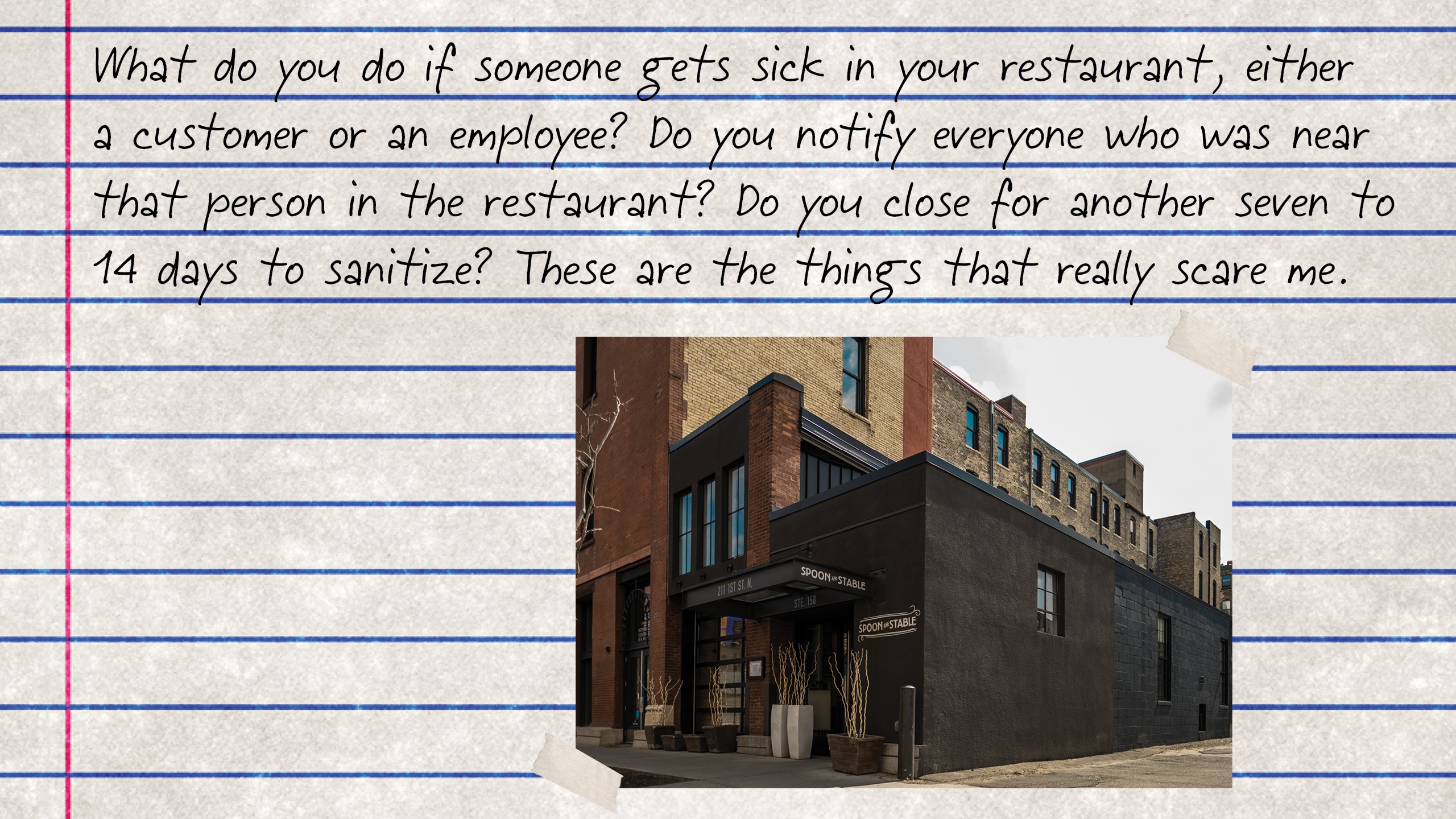
Dave Puente/Nicolas Raymond/Flickr/Graphic by Talia Moore
The optimist and the apocalypse
I’m a worst-case scenario optimist. I’m 100 percent optimistic, but I need to know worst-case scenarios so I can work through them. How do I change, update or modify my business model, not to turn a profit but to dig myself out of this hole? There’s a lot at stake if we screw up in the opening phase.
We need a minimum of six weeks to be ready to open. I definitely will not open all three restaurants at once. We’ll strategize, do it in phased openings, but I don’t know the order yet. I do know Bellecour’s season starts now, and the more we’re closed during the summer the more negative I go. It’s a seasonal restaurant that really only makes money in the summer months, so it may have to open first. And because of the bakery we could expand the take-out operation there, so it’s probably the easiest one.
I don’t know enough to answer the question of when, exactly—but if we were to get clarity this week from the governor, if he says June 1, we can slowly start to figure out what re-opening will look like, and have a bit of a plan. I wouldn’t open May 15 even if we could. It’s too soon.
I heard somebody say, We’re in the middle of a hurricane, but somebody will figure out how to sell umbrellas. That’s what we have to figure out, a way to sell umbrellas. I think that’s exciting. I have to believe that.
Hugh Acheson, who owns three restaurants in Georgia, posted on twitter that he’ll open when he’s ready to open, not when somebody tells him it’s okay to open. A little rant—he meant he’s not going to rush it—and he got something like 40,000 likes, which shows you what people like to hear, or where their heads are at. He’s not opening until he’s ready, like me.
The governor of Georgia might say that restaurants could open this past Monday, but that’s crazy. It’s not legitimate. We need consistency. If we re-opened restaurants nationally, with a stipulation of 50 percent occupancy and all these other rules, that’s great, as long as it’s consistent across the board. But how is it monitored, how do we check what everyone’s doing?
We could put all our employees through a set of questions, but if that doesn’t work, then what? Take their temperature? Take the guests’? If that would help us from a reliability perspective, given everyone a little peace of mind, maybe we would have to.
—
Strength in numbers
There’s no protocol. I’m on a panel of people giving our advice to the state, in terms of what we need to think about now, hygiene and sanitation. Because what do you do if someone gets sick in your restaurant, either a customer or an employee? Let’s say a customer ate and then tested positive the next day. Do you notify everyone who was near that person in the restaurant? Do you close for another seven to 14 days to sanitize, and what outside company even does that for you? These are the things that really scare me. I want to have a clear understanding: If there is illness, what do we do. I don’t have an aswer, yet.
I speak to colleagues here in the Twin Cities, I speak to Andrew Zimmern daily, and I get on a group call almost every day with chefs around the country, 25 to 30 people on Zoom, the majority of them chef-owners: Amanda Cohen in New York City, Katie Button in North Carolina, Dominique Crenn in San Francisco, Andrew Zimmern here in Minneapolis, Edouardo Jordan in Seattle. We’re talking through the covid crisis together, which is interesting and helpful, different voices from different parts of the country.
The people on that call, who are all very independent, tend to wonder about the national advisory committee, and what they’re going to do for us. I know two of the four chefs on the committee, Daniel Boulud and Thomas Keller, and my response, to the people on the call or anyone who asks, is that the chefs didn’t ask to be on the committee, they were appointed. And I can say wholeheartedly, having traveled with them in the last 12 years of my life, they’re not excited to go to the restaurant everyone’s already talking about, they’re excited to go to the chef they just heard of who’s supposed to be cooking great food.
I believe they will, in fact, fight for us, and for the pancake place down the street or the corner pizza place. They can get information to the powers that be. I’d like to take away all the noise around the “four older white males” stuff. It’s distracting. They want to help.
—
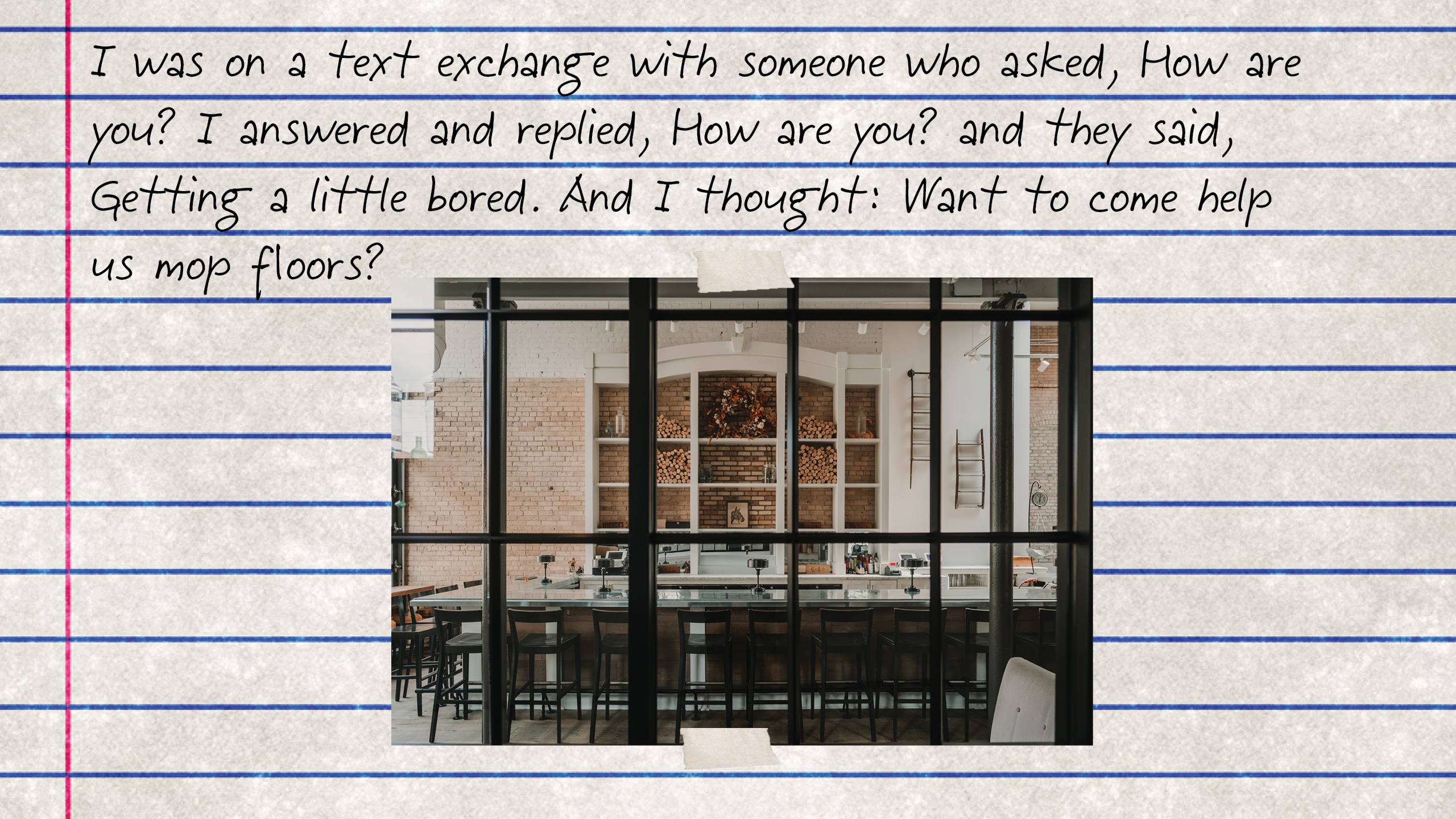
Dave Puente/Nicolas Raymond/Flickr/Graphic by Talia Moore
The waiting game
In the meantime, we’re looking into whether there is an opportunity to help the construction company that built our restaurants, little things we always wanted to fix that we can’t handle ourselves, that need some expertise. The flooring at Spoon has been beaten up the last five years, and in some places it’s buckled from the cold or humidity. It’s not bad, and it doesn’t need to be fixed immediately, but as long as we’re closed let’s just fix it right now. The handles and the cupboards get stripped and beaten up from so much use, little things like that. My business partner said, Fix it up now and you’ll be good to go, and there’s an opportunity to help these people at the same time.
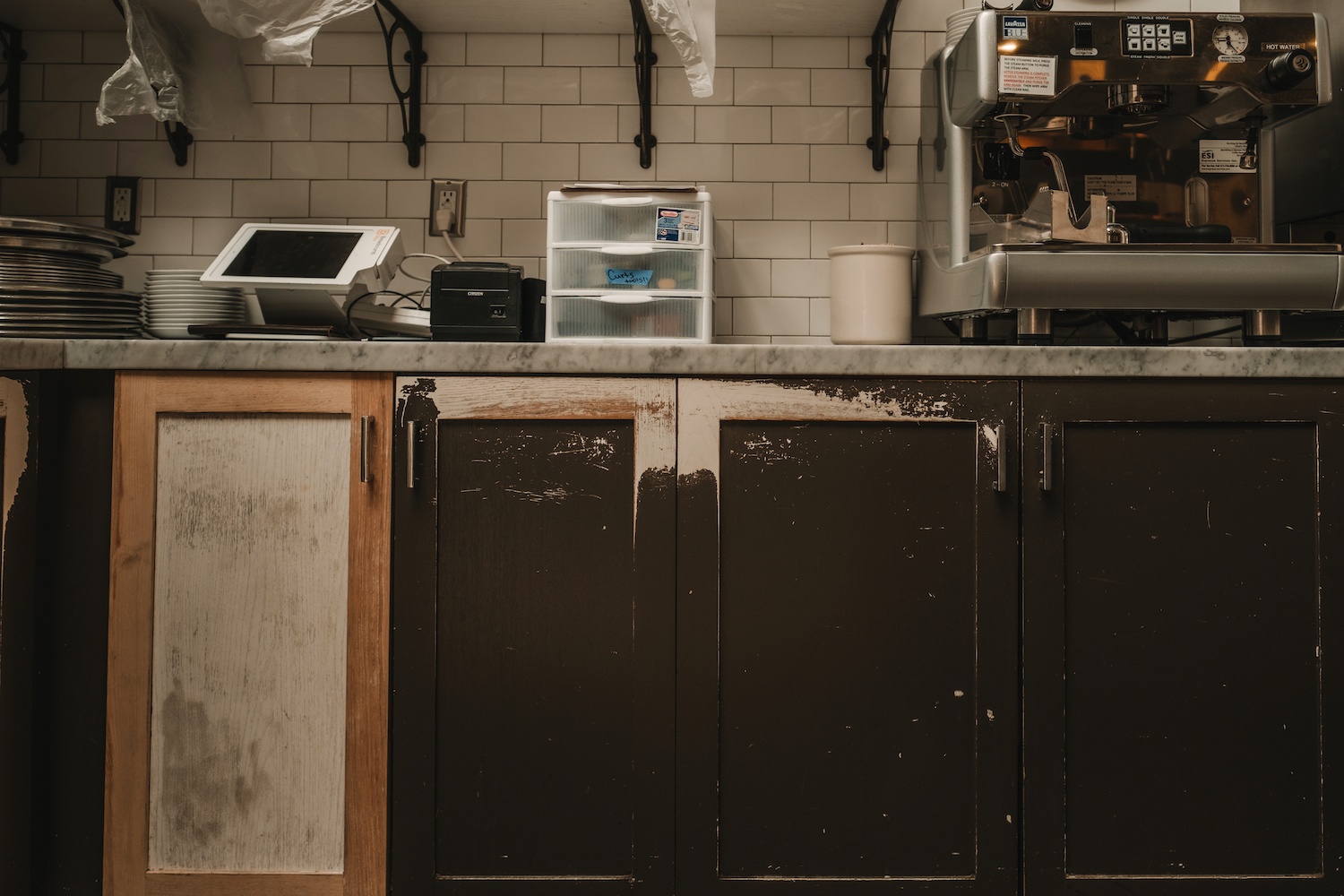
The handles and the cupboards at Spoon and Stable are beaten up from so much use.
Dave Puente
We have a huge list of projects we’ve put together, some of which we might’ve contracted out but now we just do them. And we clean every day. Normally the restaurant is cleaned pretty thoroughly every night and morning, but there’s a big staff to do that. Now those of us who are here do it. Once we re-open people are going to want to see shiny places.
I was on a text exchange with someone who asked, How are you? I answered and replied, How are you? and they said, Getting a little bored.
And I thought: Want to come help us mop floors?
—
Profit and loss
The only non-profit I run is the Heart of the House foundation. The others, the restaurants and the sports company, are for-profit businesses. I’ve said to cooks and chefs who worked for me, and are getting ready to or have opened their own restaurants, “There’s art and there’s commerce.” There’s the artistic side you won’t budge for, but there’s a business side and you have to address those concerns. I learned it from Daniel Boulud: I know how to work really hard, to look at a budget and try to come in under it, and if I don’t, to trace back to see where I took a wrong step. I actually like that portion of my job, because it keeps a sense of security for my team, which is more important than ever now.
Fine dining is tough because it’s such a small sliver of the business, but it’s probably written up the most and talked about a lot. The pizza place might not look that different after it re-opens because it already does a great takeout business, and the box for leftovers already came to the table. But the desire for that fine-dining experience, sometimes, will still exist in people who enjoy it. We just have to figure out how to do it. You have a tapas restaurant with shared plates? You can’t do that anymore, even though shared plates usually boost a check average because portions are smaller and your eyes tell you to order more. But that goes away—and that changes your business model.
I heard somebody say, We’re in the middle of a hurricane, but somebody will figure out how to sell umbrellas. That’s what we have to figure out, a way to sell umbrellas. I think that’s exciting. I have to believe that.
